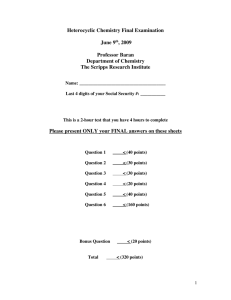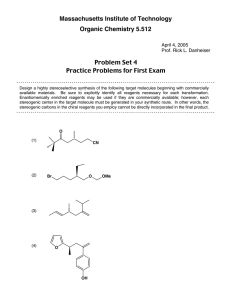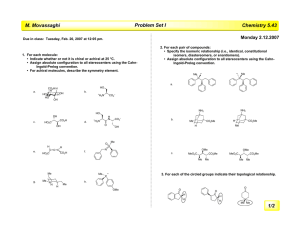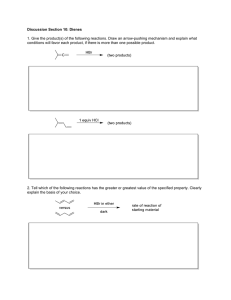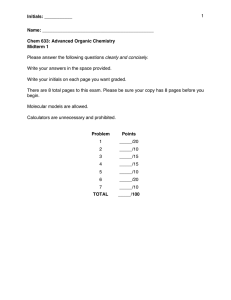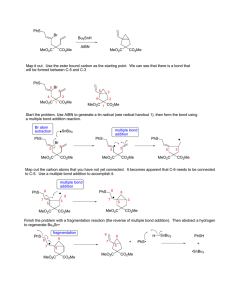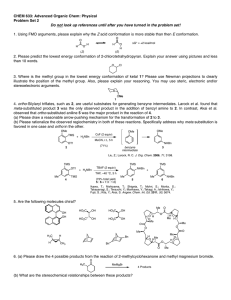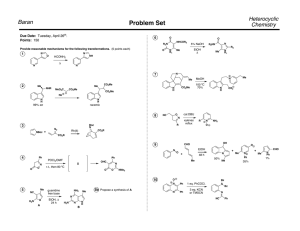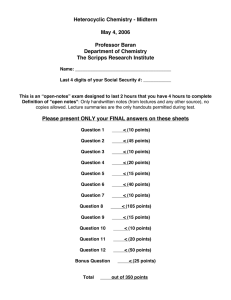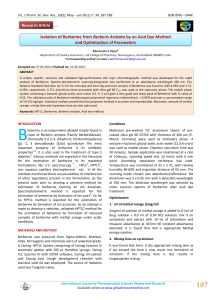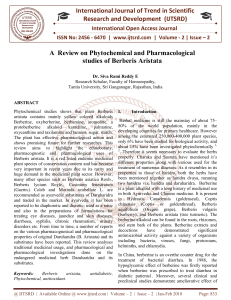Heterocyclic Chemistry – Final Exam June 7 , 2005 Professor Baran
advertisement
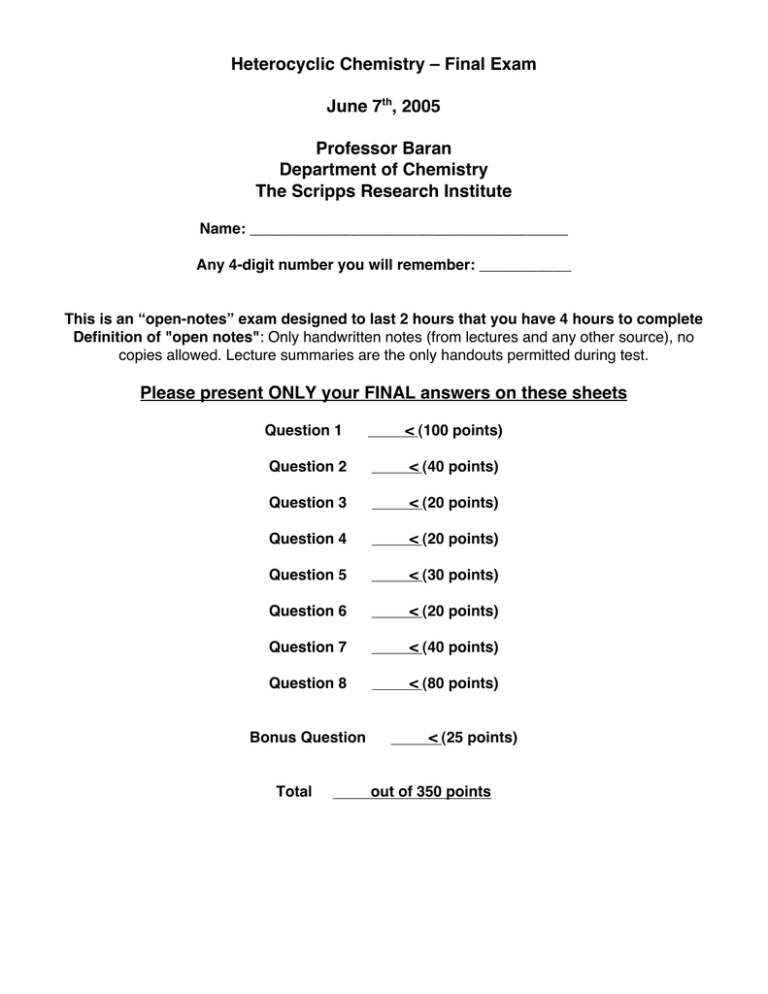
Heterocyclic Chemistry – Final Exam June 7th, 2005 Professor Baran Department of Chemistry The Scripps Research Institute Name: ______________________________________ Any 4-digit number you will remember: ___________ This is an “open-notes” exam designed to last 2 hours that you have 4 hours to complete Definition of "open notes": Only handwritten notes (from lectures and any other source), no copies allowed. Lecture summaries are the only handouts permitted during test. Please present ONLY your FINAL answers on these sheets Question 1 < (100 points) Question 2 < (40 points) Question 3 < (20 points) Question 4 < (20 points) Question 5 < (30 points) Question 6 < (20 points) Question 7 < (40 points) Question 8 < (80 points) Bonus Question Total < (25 points) out of 350 points Question 1 (100 points). Provide syntheses of the following heterocycles from simple starting materials: A. Me Me O O O O OMe OH O isorobustin B. HN S O N N N Me C. OH EtO2C NH Me N H O monastrol D. N Me E. Me N H N N O N roxane F. Indoxacarb G. O N N Cl N N NH2 H. N Me Me N O N H N H I. N N O O NH N O S F J. F N N N N H2NO2S N Me Question 2 (40 points). Propose a biogenetic hypothesis for the formation of phlegmariurine C from L-lysine. Me N Me O O H O O H phlegmariurine C N H2N H2N H L-lysine CO2H Question 3 (20 points). Based on the following HTS hit, provide a synthesis of five different analog scaffolds (each must differ in the ring systems used in the naphthalene core). O HN HO N H SMe Question 4 (20 points). Paying attention to issues of regioselectivity, propose a synthesis of pterin 8-oxide (1). Treatment of 1 with a 1:1 mixture of TFA-TFAA (1 hour, 50 °C) followed by evaporation of solvent and exposure to NaOH followed by acidification gave xanthopterin (2) in quantitative yield. Provide a mechanism for the transformation of 1 to 2. O HN H2N O N N N H N HN H2N N N O 1 2 O Question 5 (30 points). The Shamma group at Penn State has shown (J. Nat. Prod. 1986, 49, 398 – 405) that saulatine is not “natural” and is simply an artifact of isolation (silica gel chromatography using CHCl3/MeOH). Provide a mechanism for its formation from the common alkaloid berberine (20 points). Also, describe the biosynthetic origin of berberine (10 points). O MeO N O O N ? OMe MeO O berberine OMe OMe saulatine OMe Question 6 (20 points). Provide a mechanism for the Eschenmoser sulfide contraction (1 to 2), which proceeds via a heterocycle we did not discuss in class. MeO2C O H MeO2C MeO2C O MeO2C Me Me H H Me A O NH O Me N B H Me H NC CO2Me D N HN S C Me Me 1 MeO2C 3 TFA, CH3NO2 MeO2C Me Me H H Me H CO2Me D N N C Me Me Me CO2Me NC P O O A Me B NH HN H CN 2 CO2Me Question 7 (40 points). Propose a biogenetic hypothesis and total synthesis for perophoramidine. Question 8 (80 points). Deduce the structures of the following heterocycles based on the clues provided. A. (C5H8N4S) Derived from the condensation of thiourea and malonodinitrile (MeOH, MeONa), then treatment with MeI. (5 points) B. (C3H2N4S) By treatment of 2-hydrazinothiazole with nitrous acid. (5 points) C. (C9H10N6O2) By the following sequence of transformations on 1,2-dimethyl-5-nitroimidazole: 1. DMFDMA, heat, 2. Ac2O, heat, 3. guanidine. (10 points) D. (C12H11NO3) Formed upon reaction of benzoyl chloride and EtO2CCH2NC in the presence of KOt-Bu. (5 points) E. Identify compound A based on the reaction sequence given (10 points): CO2Et Me EtO2C P2O5 A X HCl Δ HO X N EtO2C CO2Et F. (C12H8N2O) Formed by simply heating the following compound (5 points): N O N3 G. (C13H9NO) Derived from 2-chlorobenzophenone by treatment with hydroxylamine followed by 50% KOH in MeO(CH2)2OH at reflux. (10 points) H. (10 points) H N 2.8 equiv. n-BuLi, -78 °C to rt then MeI, -65 °C t-Bu C12H15NS S F I. (10 points) NH2 Ph I2, EtOH S C14H10N2S J. (10 points) (EtO)2OP N + OHC S NHTs NaH (2 equiv) C7H6N2S Bonus Question (25 points): In 1976 Woodward revised the structure of isolongistrobine (Tetrahedron 1976, 32, 1085). This natural product could be converted into isomacrorine by treatment with 2:1 AcOH/HCl (concentrated) followed by oxidation. This was the biggest clue that the proposed structure was flawed since a reasonable mechanism could not be drawn for this conversion. Isolongistrobine could be further oxidized to dehydrolongistrobine (which now lacked the triplet at ca 5.1 ppm in the 1 H NMR). For 10 points, what is the real structure of isolongistrobine and dehydrolongistrobine? For 10 points, propose a total synthesis of these structures. Given that the natural products longistrobine and macrorine have the same molecular weight, what are their likely structures (5 points)? O OH N N NMe N HO isomacrorine NMe N isolongistrobine (proposed structure) 3H 1H 1H 8 1H 4H 1H 6 2H 2H 4H PPM 4 2 NMR spectrum of isolongistrobine It was a joy to have you all in class! Have a great summer! 0
